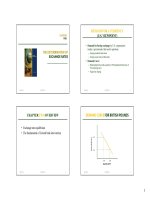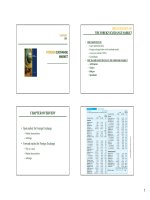Multinational financial management 7th CH04
Bạn đang xem bản rút gọn của tài liệu. Xem và tải ngay bản đầy đủ của tài liệu tại đây (1.07 MB, 42 trang )
Multinational Financial
Management
Alan Shapiro
7th Edition
Power Points by
J.Wiley
&
Sons
Joseph F. Greco, Ph.D.
California State University, Fullerton
1
CHAPTER 4
PARITY CONDITIONS
AND
CURRENCY
FORECASTING
2
CHAPTER OVERVIEW
I.
ARBITRAGE AND THE LAW OF
ONE PRICE
II. PURCHASING POWER PARITY
III. THE FISHER EFFECT
IV. THE INTERNATIONAL FISHER EFFECT
V. INTEREST RATE PARITY THEORY
VI. THE RELATIONSHIP BETWEEN THE
FORWARD AND FUTURE SPOT RATE
VII. CURRENCY FORECASTING
3
PART I. ARBITRAGE AND THE LAW OF
ONE PRICE
I.
THE LAW OF ONE PRICE
A. Law states:
Identical goods sell for the
same price worldwide.
4
ARBITRAGE AND THE LAW OF ONE
PRICE
B. Theoretical basis:
If the price after exchange-rate
adjustment were not equal,
arbitrage in the goods worldwide
ensures eventually it will.
5
ARBITRAGE AND THE LAW OF ONE
PRICE
C. Five Parity Conditions Result
From These Arbitrage Activities
1. Purchasing Power Parity (PPP)
2. The Fisher Effect (FE)
3. The International Fisher Effect
(IFE)
4. Interest Rate Parity (IRP)
5. Unbiased Forward Rate (UFR)
6
ARBITRAGE AND THE LAW OF ONE
PRICE
D. Five Parity Conditions Linked
by
1. The adjustment of
various
rates and prices to
inflation.
7
ARBITRAGE AND THE LAW OF ONE
PRICE
2.
The notion that money
should have no effect on
real variables (since they
have been adjusted for
price changes).
8
ARBITRAGE AND THE LAW OF ONE
PRICE
E. Inflation and home currency
depreciation:
1. jointly determined by the
growth of domestic money
supply;
2. Relative to the growth of
domestic money demand.
9
ARBITRAGE AND THE LAW OF ONE
PRICE
F. THE LAW OF ONE PRICE
- enforced by
international
arbitrage.
10
PART II. PURCHASING POWER
PARITY
I. THE THEORY OF PURCHASING
POWER PARITY:
states that spot exchange rates
between currencies will change
to the differential in inflation
rates between countries.
11
PURCHASING POWER PARITY
II.
ABSOLUTE PURCHASING
POWER PARITY
A. Price levels adjusted for
exchange rates should be
equal between countries
12
PURCHASING POWER PARITY
II.
ABSOLUTE PURCHASING
POWER PARITY
B. One unit of currency has
same purchasing power
globally.
13
PURCHASING POWER PARITY
III. RELATIVE PURCHASING
POWER PARITY
A. states that the exchange
rate of one currency against
another will adjust to reflect
changes in the price levels
the two countries.
of
14
PURCHASING POWER PARITY
1.In mathematical terms:
et
e0
where
e0 =
ih =
if =
t =
(1 +
ih
=
(1 + i f
)
)
t
t
et = future spot rate
spot rate
home inflation
foreign inflation
the time period
15
PURCHASING POWER PARITY
2. If purchasing power parity is
expected to hold, then the best
prediction for the one-period
spot rate should be
et = e0
(1 + ih )
(1 + i )
t
t
f
16
PURCHASING POWER PARITY
3. A more simplified but less precise
relationship is
et
= ih − i f
e0
that is, the percentage change should be
approximately equal to the inflation rate
differential.
17
PURCHASING POWER PARITY
4.
PPP says
the currency with the higher
inflation rate is
expected to
depreciate
relative to the
currency
with the lower rate of inflation.
18
PURCHASING POWER PARITY
B. Real Exchange Rates:
the quoted or nominal rate
adjusted for a country’s
inflation rate is
et' = et
(1 + i f ) t
(1 + ih ) t
19
PURCHASING POWER PARITY
C. Real exchange rates
1. If exchange rates adjust to
inflation differential, PPP
states that real exchange
rates stay the same.
20
PURCHASING POWER PARITY
C. Real exchange rates
2.
Competitive positions:
domestic and foreign
firms
are unaffected.
21
PART III.
THE FISHER EFFECT (FE)
I. THE FISHER EFFECT
states that nominal interest
rates (r) are a function of the
real interest rate (a) and a
premium (i) for inflation
expectations.
R = a + i
22
THE FISHER EFFECT
B. Real Rates of Interest
1. Should tend toward equality
everywhere through arbitrage.
2. With no government
interference nominal rates vary
by inflation differential or
rh - r f = i h - i f
23
THE FISHER EFFECT
C. According to the Fisher
Effect,
countries with higher
inflation rates have higher
interest rates.
24
THE FISHER EFFECT
D. Due to capital market
integration globally, interest
rate differentials are
eroding.
25









